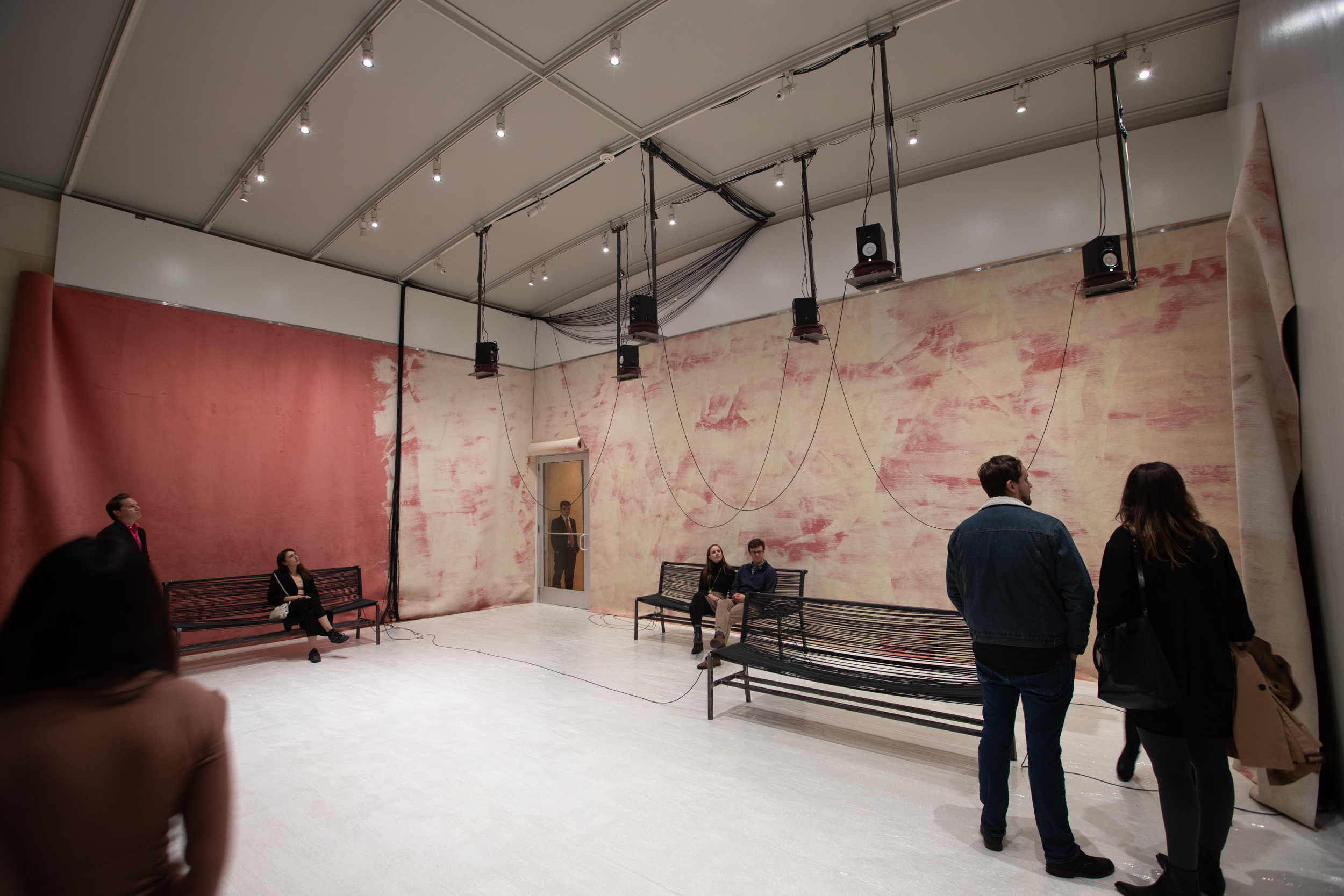A chirping, robotic voice welcomes you, spilling from one of six speakers that swivel overhead: “Welcome to the sperm bank!”
French artist Anne Le Troter’s site-specific sound installation, which debuted at the Nasher Sculpture Center last Saturday and will run through February 2, 2020 as part of the Sightings series, presents a 17-minute piece that centers on language, like much of her work, confronting the slipperiness of the identity politics inherent in its materiality, in this case in the domain of eugenics.
In a room paneled with rose-colored carpet, six speakers rotate on circular turntables above our heads, black audio cables swung between them, drooping, being pulled up, like fishing lines or nets—for language, perhaps, or for answers.
Curator Leigh Arnold met Le Troter at the Salon de Montrouge in 2016, where Le Troter’s piece “L’Appétance” (“Desire”) stood out to her: molded blue plastic seats of the kind you’d see in a Métro station, with speakers mounted under them that emitted whisperings. Le Troter had worked with ASMR artists for the recordings. Arnold was struck by these words that appeared public in context, but heard with a hushed intimacy akin to eavesdropping—the tension of public and private and words showcased as a site of slippage. For her Sightings piece, her first U.S. commission, Le Troter’s seed notion came from a flight to the U.S., when a woman seated next to her explained her work at a sperm bank. Le Troter later signed onto the website, baffled by this world. The Nasher recording, using sourced words, borrowed language from 400 donor interviews, is, similarly, an exercise in voyeurism, an intrusion on genetics.
In the gallery, the wash of words gathered and remixed is both chilling and lulling, its childlike nursery-rhyme cadence broken by artificial, scientific intrusions. “He is very sweet…incredibly sweet…is your typical sweetheart…like a big teddy bear…” male and female voices drone, enumerating a litany of positive qualities and attributes that reflect our values back at us. The breakdown begins immediately. Le Troter has arranged clusters of disjointed phrases around adjectives: “…a very active person…very intelligent,” or “has his work published in several journals,” or again adventurous, outdoorsy, practical, “loves his dogs.” “I came from…,” a donor voice begins, while robotic voices break in with numbers, “Donor 5165, 5155…,” a small cascade that washes and eddies in the repeated “And, um…,” a refrain that Le Troter sees like a beating heart.
And while the soft, carpeted walls and soothing voices create a cocoon of intimacy, I feel the twinge of danger, the threat in a piece that frames desire and exchange. If the room is a womb, then a womb for what?
The pink carpet on the walls has been swabbed and color-drained with bleach: the erasure of individuality imprinted on the space. Its whiteness bleeds as pigment-absence down to the off-white carpet, which is cellophane-wrapped, asepticized. The adjective clusters remove individuality, Le Troter says: a word is more saleable than a person.
Windows that look out onto Flora Street with its slow-moving traffic and burbling fountain add to the disquieting, womb-like effect. We are looking out at the world from inside what is, quite literally, a bubble. We sit on benches, also strung with audio cable, solid as the genetics encoded in DNA. That is, solid and also not solid. Unsettling and also human. Everything about the piece both holds and destabilizes.
What, really, do we know about what we want? What would it mean to engineer a calculated linguistic expression of desire? What would it entail, ethically, to sculpt a human future? And, underlying this, are the questions of privilege.
“This concludes…interviews with…400 sperm donors…Thank you, and goodbye,” the voice intones.
Le Troter herself, wearing a soft pink sweater the color of the walls, on the Friday before the opening, discussed the crafting of the piece, the real voices taken, borrowed, not as identifiable as faces, though dots on the wall represent photographs of the donors as children. The piece is a body with organs, a machine-body made of words and the audio cables the sinews of her work. She remembered the fountain and the view of the outside world, its slow rhythm.
And this space, sequestered from other galleries, may be the best exhibiting conditions she’s ever experienced, she says. At the Palais de Tokyo in Paris, another piece of hers is currently part of a group exhibition that explores the idea of a current, contemporary “French scene” in the art world. The fragility of a sound installation is challenging in a group show with images. Here, we have a cocoon with an aperture on language and thought and sculpture as sound.
The piece is on view at the Nasher through February 2, 2020.





